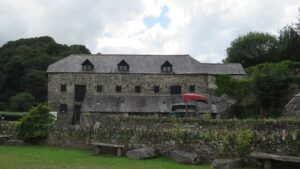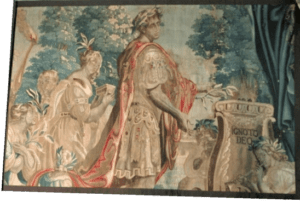Ertach Kernow - Tamar Valley medieval jewel
The Tamar Valley Area of Outstanding Natural Beauty (AONB) lies on the border of Cornwall and Devon. Primarily the River Tamar but also the rivers Lynher and Tavy form an important part of the landscape and help define this area which as well as being designated an AONB but also an important part of the Cornwall and West Devon Mining Landscape World Heritage Site. The Tamara Landscape Partnership Scheme was officially launched in May 2021, a five-year project that involves 10 sub-projects aimed at four sectors People and Communities, Heritage, Access and Sustainable Tourism and Farming and Land Management. The recent opening of the new 87-mile walking route that stretches between the South and North coast, roughly following the River Tamar, will open up many opportunities to explore and learn about this area of Cornwall and just beyond the border into Devon.
The border of Cornwall was set on the east side of the River Tamar by King Æthalstan in 936 and over the centuries, to the present day, Cornish folk have stubbornly ensured that this national border remains intact between Cornwall and England. The recent attempts to have a cross border parliamentary constituency and other joint concepts named ‘Devonwall’ have for the moment been seen off. The new Tamara Landscape Partnership Scheme shares and benefits both sides of the border, just as there has been family movement back and forth across the border area since time immemorial. The 87-mile route adds to the existing coastal path around the long Cornish coast making it possible to circumnavigate the whole of Cornwall.
One of the jewels of the Tamar Valley on the Cornish side of the border is the National Trust estate at Cotehele which was given to the National Trust in 1947 by Kenelm the 6th Earl of Edgcumbe. The Manor of Cotehele came to the Edgcumbe family via the marriage of William Edgcumbe to an heiress Hilaria de Cotehele in 1353, with some of the buildings from that time still surviving. Built around a courtyard the chapel was complete by 1411 when it was first consecrated and the remaining buildings by the mid-15th century. The Edgcumbe family survived the Wars of the Roses, Richard Edgcumbe siding with Henry Tudor against Richard III. Richard’s son Piers married the heiress, Joan Durnsford, who brought the land at Mount Edgcumbe into the family. Piers chief legacy at Cothele was remodelling of the great hall by widening it and moving the south wall further into the courtyard, this was completed before 1520. There is a wonderful range of weapons to be seen in the Great Hall including swords, shields, halberds, axes and early guns.
Cotehele is a wonderful medieval house that has remained largely suspended in time so when visiting be prepared for climbing many stairs to visit various bedrooms, dining rooms, the chapel and tower. There are many small features to observe such as small rooms with no apparent use, some windows and slits that look into other rooms such as the Great Hall, perhaps remnants of an even earlier level of construction. One of the marvels of Cotehele is its collection of around 50 medieval tapestries, most of which were purchased second hand and produced originally in Brussels although there is one that is English. This collection is the second largest to that of Hardwick Hall owned by the famous Elizabethan noble lady, best remembered as Bess of Hardwick. These tapestries surround the walls in many rooms, perhaps the wallpaper of the day and were immensely expensive at that time. The kitchen with the large cooking hearth and cloam oven are interesting along with many other small details and items from that period.
Outside the main house there are 26 acres of gardens and orchards. Four separate gardens, East Terrace, Upper Garden, The Valley Garden and The Cut Flower Garden offer a variety of plants and layouts. Sitting outside overlooking the East Terrace with its seasonally mixed borders beyond the gardens there are wide views over Calstock and the Calstock Viaduct. The Upper Garden has a central pond with summer flowering red and white-water lilies surrounded by herbaceous borders and The Valley Garden includes a thatched Victorian summerhouse and medieval dovecot and stew pond. The Cut Flower Garden provides flowers for the house and seasonal displays there. All in all, a very varied selection of gardens. The Orchard Gardens have over 125 varieties of apples and in the Old Orchard trees that include apples, cherries, plums and medlars.
Originally a stopping point for small ferries to the estate, Cotehele Quay lying on the River Tamar is an interesting and pleasant place to spend time especially if sunny. Growing busier during the 19th century, due to poor roads like most of Cornwall, it was used for import and export from the estate. This period saw most goods moved around the coast of Cornwall utilising river networks and coastal harbours. Cotehele Quay being just 15 miles from the port at Plymouth would have been very busy in loading mine produce from the estate such as silver, lead and copper with the woodlands supplying timber for shipbuilding. Imports included coal and limestone illustrated by the remains of limekilns, which turned the limestone into lime fertiliser, close to the quay. The areas landscape and soil saw an ideal location for of market garden produce including apples, strawberries, cherries and other vegetables.
The former 19th century Edgcumbe Arms Inn, which would have been busy with workers during Cotehele Quay’s industrial heyday, is now the Edgcumbe Tea-room. On the quay is the Discovery Centre which has a lot of information about the estate and its activities. Those interested in ships will be pleased to see the Shamrock a Tamar sailing barge built at Stonehouse, Plymouth in 1899. Used initially as a cargo vessel to transport manure between the Torpoint Manure Works and Plymouth she had a long service even travelling around the Cornish coast. After being abandoned and left in a deteriorating state she was purchased in 1970 by John Fildew, who appreciated her importance, and later taken over for restoration by the National Trust in 1974. By 1979 the work was completed, and she sailed on the Tamar again in 1981.
Besides all this there are the woodlands. For those wanting a walking experience, the Cotehele estate has up to 1300 acres to choose from. The Cotehele and Bohetherick Woodland Walk is a 2.3-mile circular walk from the quay encompasses some of the oldest trees and semi natural ancient woodlands. There are streams and footbridges along the way and Cotehele Mill a Victorian watermill and workshop where when fully operational flour is produced using a working waterwheel. This 19th century mill would have replaced an earlier one on this site and there is lots to see. Within this area there is a wide variety of flora and fauna and Cotehele is well-known for its population of bats where eight of the seventeen species of bats found in the UK live. Best seen in the spring they can be found in good numbers around Cotehele Quay where certain species hibernate over winter in the old limekilns. The evenings are the best times to see these nocturnal creatures swooping and feeding over the river in an extraordinary Tamar Valley experience.
Within the grounds walkers will see the small Chapel in the Woods originally dedicated to St George and Thomas Becket, built by Sir Richard Edgecumbe about 1490. This a simple rough built but attractive chapel with some original 15th century bench ends. There is also the three-sided 60-foot Prospect Tower a 18th century folly built by Richard Edgcumbe, 2nd Earl of Mount Edgcumbe, thought to mark the visit of George III to Cotehele in 1789. There was originally an internal staircase which had fallen to ruin and was replaced by the National Trust in 1947 on taking over the estate. Following further tower renovation in 2018 Prospect Tower can be accessed by visitors and climbed.
Following the family moving to Mount Edgcumbe in the 18th century, use of Cotehele by the family was only from time to time but especially after Mount Edgcumbe was bombed and gutted during World War II. Cotehele has remained largely undisturbed leading it from as early as the late 18th century to become a tourist attraction. Besides early tours by wealthy visitors a royal visit took place in 1789 by George III and Queen Charlotte. She was very taken with the house saying, ‘At breakfast we eat off the old family pewter, and used silver knives, forks and spoons which have been time immemorial in the family and have always been kept at this place.’ Today visitors can enjoy not just the house, but the whole vast estate and one visit will certainly not be enough to do it justice.









![Ertach Kernow - 26.07.2023 [1] Tamar Valley medieval jewel - Cotehele Estate](https://www.cornwallheritage.com/wp-content/uploads/2023/08/Ertach-Kernow-26.07.2023-1-254x300.jpg)
![Ertach Kernow - 26.07.2023 [2] Tamar Valley medieval jewel - Cotehele Estate](https://www.cornwallheritage.com/wp-content/uploads/2023/08/Ertach-Kernow-26.07.2023-2-254x300.jpg)
![[161] Ertach Kernow Heritage Column - 26th July 2023 - Cornish museum activity Ertach Kernow Heritage Column - 26th July 2023 - Cornish museum activity](https://www.cornwallheritage.com/wp-content/uploads/2023/08/161-Ertach-Kernow-Heritage-Column-26th-July-2023-Cornish-museum-activity-285x300.jpg)